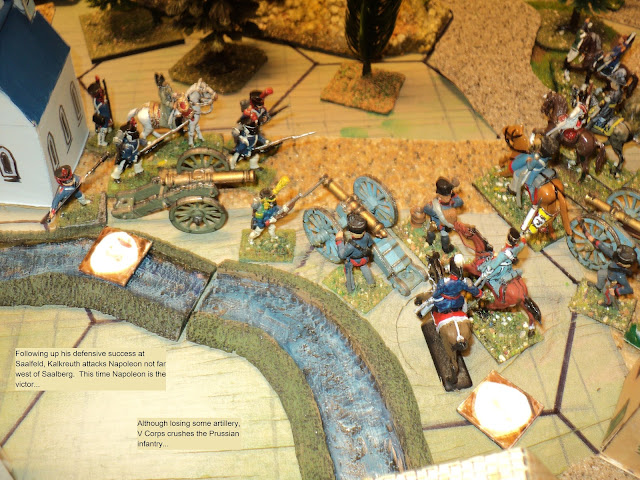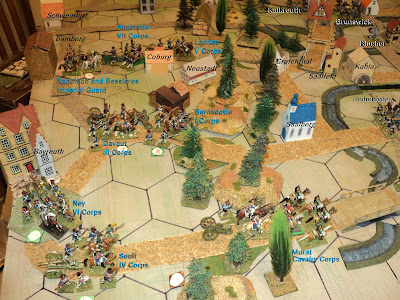I have left off the SP values, to be revisited on another occasion. However, if you go back to my account of BARFist Revolution in Tchagai ('Long Live the Revolution') and the 'Unquiet Flows the Mius' posting, you will see how what I have in mind would work.
It was in the drawing up of the following that I began to think I ought to thank Neil for his 'MHO' as the results are very simple. I've left of the Strength Points (SP) for the moment, in favour of
Infantry: 1 stand per company
Armour: 1 AFV per company/ squadron
Artillery: 1 stand per battalion
Panzer Division, mid-1944:
2 Panzer Battalions, 4 Panzergrendier Battalions, Artillery Regiment of 4 battalions (2 of armour, 4 of motorised foot, and 4 gun/howitzers)Command(1): any sort of command vehicle and CO
Logistics: 1x lorry and/or tanker per 'arm'
Panzer Battalion: 4 Panther
Panzer Battalion: 5 PzIV (2)
Panzergrenadier Battalion(3) (gepanzert): 4 stands plus armoured halftrack
Panzergrenadier Battalion (motorised): 4 stands plus truck
Panzergrenadier Battalion (motorised): 4 stands plus truck
Panzergrenadier Battalion (motorised): 4 stands plus truck
Artillery SP Battalion: 1x Wespe or Hummel self propelled artillery
Artillery Battalion: 1x 15cm Howitzer
Artillery Battalion: 1x 10.5cm Howitzer
Artillery Battalion: 1x 10.5cm Howitzer
(1) The command element will have the formation's integral AA capability, which may, but need not, be depicted by an AA weapon as part of the HQ element (unit of manoeuvre). This goes for the formation command elements of all the following.
(2) By mid-1944, the respective panzer battalion establishments comprised 78 Panther and 98 Panzer IV tanks, organised into 4 companies in each battalion plus a reconnaissance platoon. So it would appear that the Panther companies comprised 17 AFVs and the Panzer IV, 22 AFVs. I suggest 5 PzIVs to the battalion instead of 4 to reflect the numerical disparity between the panzer battalions.
(3)The panzergrenadier battalions - infantry stands count as an integral whole, as though all mounted on a single stand or sabot. I prefer not to use the oversized stands (shudder), as they have certain problems of their own that I prefer to avoid. The 5 separate stands can be arranged as one likes upon a single grid area, or astride a grid edge or corner signifying the battalion's occupation of both (edge) or all three or four (corner) grid areas.
Soviet Tank Corps:
Command: CO plus any sort of command vehicleLogistics: 1 lorry and/or tanker per brigade or regiment (ideally)
Tank Brigade(4):
3 Tank
Motor Rifle Battalion: 3 SMG stands (tank desantski)
Tank Brigade:
3 Tank
Motor Rifle battalion: 3 SMG stands, (tank desantski)
Tank Brigade:
3 Tank
Motor Rifle Battalion: 3 SMG stands, (tank desantski)
Motor Brigade(5):
Motor Battalion: 4 stands, 1 truck
Motor Battalion: 4 stands, 1 truck
Motor Battalion: 4 stands, 1 truck
Field Gun and/or Mortar Battalion: 1x 76.2 field gun and/or 1x 120mm mortar.
Mortar Regiment: 3 x 120mm mortar plus truck
Artillery Regiment: 3 x 76.2mm field guns plus tractors
AA Regiment: 1 x 37mm AA, 1 x AAMG, 2 trucks
Rocket Battalion: 1x truck mounted BM13 'Katyusha'
Assault Gun Battalion:
1 x Su85 or Su100 or Su76
Heavy Tank Battalion: 1x IS2 (or KV85 late 1943)
'Motorcycle Company': 1 M/c mounted SMG, 1 BA32 armoured car.
(3) The Tank and SMG stands together count as an integral whole, the presence of the SMG stand identifying the armoured element as part of a Tank Brigade, as distinct from a Tank Regiment.
(4) Owing to, and to reflect, the manpower difficulties experienced by the Red Army, the Motor Brigade may be consolidated into a single unit of 6 infantry stands plus 1 or 2 trucks.
German Regular Infantry Division 1944 (E.g. 352nd Division at Omaha Beach)
Command: CO plus command vehicleLogistics: Lorries, pack horses or wagons
Schutzen Regiment 914:
I Battalion: 4 Schutzen Inf stands
II Battalion: 4 Schutzen Inf Stands
Schutzen Regiment 915:
I Battalion: 4 Schutzen Inf stands
II Battalion: 4 Schutzen Inf Stands
Schutzen Regiment 916:
I Battalion: 4 Schutzen Inf stands
II Battalion: 4 Schutzen Inf Stands
Fusilier Battalion 352:
4 Fusilier Infantry stands
Panzerjager Abt 352(5):
Stug Company: 1x StuGIIIG
Marder Company: 1x MarderII, III or 38
AA Company: 1x 20mm portee mounted AA gun(s)
Artillery Regiment 352:
1x 15cm howitzer, plus tractor
3x 10.5cm howitzer; plus tractors.
(5) Panzerjager companies were numerically rather weaker than the AFV companies of Panzer Divisions (10 StuGs and 14 Marders, c.f. 17 Panthers and 22 Panzer IVs). However, they were a significant enough part of the Division that they ought to be separately included. Not all Divisions were so 'lavishly' equipped.
Soviet Mechanised Corps (6):
Command: CO plus command vehicleLogistics: Trucks or half-tracked trucks
Tank Brigade:
3x Tank Battalions(7): 1 Tank, 1 SMG infantry stand (tank desantski)|
Mechanised Brigade:
Tank Regiment: 2 tank
Motorised Infantry(8,9):
Motor Rifle Battalion: 4 stands, 1 truck
Motor Rifle Battalion: 4 stands, 1 truck
Motor Rifle Battalion: 4 stands, 1 truck
(AT Rifle Coy: 1 stand PTRS)
(Mortar Battalion: 1x 12cm mortar)
(Artillery Battalion: 1x 76.2mm field gun)
(AAMG Coy: 1 x AAMG)
Mechanised Brigade:
Tank regiment: 2 tank
Motorised Infantry:
Motor Rifle Battalion: 4 stands, 1 truck
Motor Rifle Battalion: 4 stands, 1 truck
Motor Rifle Battalion: 4 stands, 1 truck
(AT Rifle Coy: 1 stand PTRS)
(Mortar Battalion: 1x 12cm mortar)
(Artillery Battalion: 1x 76.2mm field gun)
(AAMG Coy: 1 x AAMG)
Mechanised Brigade:
Tank Regiment: 2 tank
Motor Rifle Battalion: 4 stands, 1 truck
Motor Rifle Battalion: 4 stands, 1 truck
(AT Rifle Coy: 1 stand PTRS)
(Mortar Battalion: 1x 12cm mortar)
(Artillery Battalion: 1x 76.2mm field gun)
(AAMG Coy: 1 x AAMG)
Mortar Regiment:
1x120mm Mortar, 1 truck
Guards Mortar Battalion:
1x BM13 'Katyusha'
Assault Gun Regiment: 1x Su76
Assault Gun Regiment: 1x ISU122
Assault Gun Regiment: 1x ISU152 (10)
(6) The Mechanised Corps is a big and powerful formation - almost (as I thought the Soviet Mechanised Brigade under Command Decision rules) the ideal War Games formation.
(7) The Tank Battalions in the Tank Corps and the Mech Corps Tank Brigade were about the size of a full strength Panzer Company. So all 3 Soviet tank battalions have in this organisation been merged into 1 stand, plus the SMG stand (detached from the Brigade's motor battalion).
(8) Alternatively, recognising that attrition played merry hell with the Red Army's Divisional manpower, each Brigade's motorised infantry may be consolidated into a single 'unit' of 6 stands
(9) Elements in parentheses are optional
(10) Absent the Tank Brigade, all other armour, and the Rifle battalion motor vehicles; substutute assault guns for equivalent towed artillery, and you'll have a 'leg' Infantry Division.
Additional equipment in the way of artillery, rockets, heavy tanks, special assault gun units, engineers, and reconnaissance units, may be supplied, per campaign or scenario, from 'Army' inventories.
Just for the sake of interest, here is a...
Luftwaffe Division:
Command: CO, command vehicle, (optional) AA (see Note 1 supra), (optional) Fusilier Coy of 1 stand.Logistics: Truck.
Jager Regiment:
Battalion: 4 stands
Battalion: 4 stands
Battalion: 4 stands
Jager Regiment:
Battalion: 4 stands
Battalion: 4 stands
Battalion: 4 stands
Artillery Regiment:
3 x 10.5 cm howitzer plus horsed traction
AA Abteilung:
1 x 8.8cm FlaK (in AT role) plus horsed traction
Megablitz or Hexblitz, this isn't. In scale it lies between Command Decision and those operational level game systems. I was thinking of calling the system Kilo-blitz or Killer-blitz, but why not go all alliterative...(?)
... Kilokrieg
Possibly more to come...

































.jpg)



















